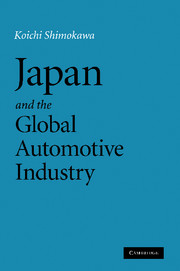Book contents
- Frontmatter
- Contents
- List of figures
- List of tables
- Preface
- Introduction
- 1 Comparing productivity of the Japanese and US automobile industries
- 2 The internationalization of the Japanese automotive industry and local production overseas
- 3 The recovery of European and US auto makers, and relocating and changing lean production
- 4 Early 1990s – the Japanese automotive industry loses international competitiveness, and the development of restructuring strategies
- 5 The restructuring of the global automotive and auto-parts industries
- 6 The restructuring of the world's auto-parts industry and the transfiguration of the keiretsu parts transaction
- 7 Global M&A and the future of the global auto industry – the light and dark sides of merger and re-alignment
- 8 The Asian and ASEAN automotive industries in the global era
- 9 China's automotive industry in the global era, Japanese auto makers, and their China strategies
- 10 Conclusion – the global automotive industry's perspective on the twenty-first century and tasks for the Japanese automotive industry
- Epilogue
- Index
- References
5 - The restructuring of the global automotive and auto-parts industries
Published online by Cambridge University Press: 06 July 2010
- Frontmatter
- Contents
- List of figures
- List of tables
- Preface
- Introduction
- 1 Comparing productivity of the Japanese and US automobile industries
- 2 The internationalization of the Japanese automotive industry and local production overseas
- 3 The recovery of European and US auto makers, and relocating and changing lean production
- 4 Early 1990s – the Japanese automotive industry loses international competitiveness, and the development of restructuring strategies
- 5 The restructuring of the global automotive and auto-parts industries
- 6 The restructuring of the world's auto-parts industry and the transfiguration of the keiretsu parts transaction
- 7 Global M&A and the future of the global auto industry – the light and dark sides of merger and re-alignment
- 8 The Asian and ASEAN automotive industries in the global era
- 9 China's automotive industry in the global era, Japanese auto makers, and their China strategies
- 10 Conclusion – the global automotive industry's perspective on the twenty-first century and tasks for the Japanese automotive industry
- Epilogue
- Index
- References
Summary
Introduction
The end of the Cold War, the rapid spread of information technology, and international economic globalization have revolutionized many industries, starting with the financial and securities industries and then spreading to the fast-growing information and communication industries. The automobile industry is no exception.
Prior to the global shake-up, the automobile industry, especially in advanced countries, was primarily a national industry, no matter how international its business. Trade disputes, for example, related to the correct way to handle automobile trade, the balance of trade, and job security for a country's labor force. The automobile industry also impacted a wide range of related industries, such as components and materials, on a national level. Because of this background, automobile manufacturers in advanced nations constructed management strategies that centered on their own country. Their overseas strategies were tightly connected to the domestic strategy and had a strong tendency to complement them, no matter how important overseas business and exports were to the company. Therefore car manufacturers' competitiveness was closely related to how competitive they were in their domestic markets and, up until the massive globalization boom of the 1990s, automobile industries competed with each other at a nation-to-nation level. At the same time, the Japanese automobile industry had grown rapidly by introducing lean production methods, which sparked reform in Western companies to remain competitive and led to the globalization of the automobile industry in the 1990s.
- Type
- Chapter
- Information
- Japan and the Global Automotive Industry , pp. 135 - 166Publisher: Cambridge University PressPrint publication year: 2010

